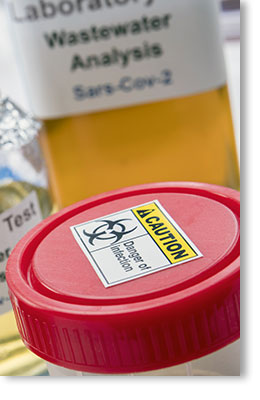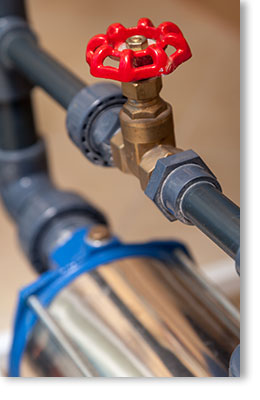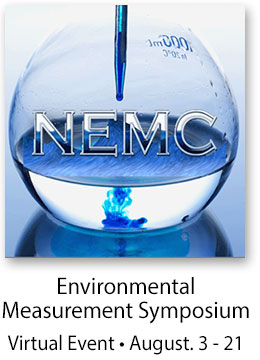
In this issue:
COVID-19 in Wastewater
Testing water in building re-opening
Sodium Thiosulfate
NEMC Virtual Conference
John Dalton & Atomic Theory

One of the most frustrating aspects of the current pandemic has been that identification and extent of community outbreaks is tied to the number of test kits available and limited to individuals already experiencing symptoms.
Finding a quick way to locate and identify disease outbreaks before they manifest in the community has researchers focusing their attention on a surprising yet familiar matrix—wastewater.
“There is real hope that this can be a sensitive, early warning” if, as officials ease social distancing measures, Covid-19 begins to spread again, according to the nonprofit Water Research Foundation. “Several labs have achieved a proof-of-concept in terms of demonstrating the ability to detect the RNA [genetic material] of the virus in wastewater.”
Studies in the U.S. and the Netherlands, among others, have shown you can pick up a signal about a week before the first clinical case.
“Wastewater epidemiology” has been used for decades to detect polio in countries where the disease remains endemic and, more recently, to estimate the prevalence of opioid abuse in U.S. communities.
“We know that the virus that causes Covid-19 is shed in stool, which means it can be collected in sewage systems,” said Megan Murray of the Harvard T.H. Chan School of Public Health. In small studies so far, the detection of the new coronavirus in sewage samples “has correlated with the arrival of Covid-19 into different communities,” she added, including picking up “significant amounts of viral material” in Boston sewage weeks before cases arrived in March.
In the case of Covid-19, the absence of a vaccine makes early identification of community outbreak paramount if we wish to contain and eradicate it. If it is known that the virus is active before people exhibit symptoms, members of the community can be cautioned to practice social distancing and sensitive populations can be advised to self-isolate in advance of widespread exposure. This is critical if we wish to re-open businesses and public spaces in a safe and responsible manner.
Wastewater testing, while unhelpful in identifying and tracking infected individuals, may equip states with the data they need to identify and contain COVID-19 hot-spots and flareups, while allowing non-detect communities to cautiously resume normal community operations.
Sources:
https://www.statnews.com/2020/05/28/wastewater-testing-gains-support-as-covid19-early-warning/https://www.babcocklabs.com/news/the-path-out-of-coronavirus-lockdown-follow-the-wastewater/2020

Commercial buildings across the U.S.–including schools, office buildings, hotels, resorts, restaurants, childcare facilities and more–have closed their doors for a prolonged period of time amid shelter-in-place orders due to COVID-19 pandemic. As some states begin to ease shelter-in-place orders and reopen commercial facilities, water quality concerns must be addressed and resolved.
The two biggest drinking water quality threats to consider as buildings begin to reopen following prolonged closures are disinfectant residuals and corrosion of metals, according to Erica Walker, director of policy and programs for 120Water.
“Disinfectant residuals can be depleted as stagnant water sits in plumbing,” Walker said. Warm long-stagnant water produces favorable conditions for the growth of organisms and bacteria like legionella, which can lead to the pneumonia-like illness called Legionnaires’ disease.”
The second water quality concern building managers should consider when reopening buildings following prolonged closures due to COVID-19 concerns is the potential corrosion of metals. Ordinarily, water utilities have corrosion control chemicals continuously flowing through most drinking water pipes in regular use to protect pipes and drinking water fixtures from eroding. However, in prolonged periods of building closure, many pipes and fixtures may be at a heightened risk due to dramatically reduced exposure to these chemicals. That risk is compounded by the fact that many drinking water fixtures in use are composed of up to 8% lead, a standard that was only recently lowered in 2014.
Various authoritative sources recommend a regimen of flushing the water system and testing for contaminants, such as harmful bacteria and increased levels of lead and other metals. The CDC has guidance for addressing building water systems following a prolonged shutdown. Information can be found at the CDC’s coronavirus building water systems guidance page.
Additional resources for re-opening building water systems can be found at the Purdue University Center for Plumbing Safety, and NSF International.
Digested from material published by Water Quality Products. Follow this link to read the entire article.
QEC screw cap sterile containers are available with and without sodium thiosulfate.
For information on QEC's complete line of sterile, sealed containers, please contact our customer service team.
Sodium thiosulfate is a dechlorinating agent that neutralizes any residual halogen and prevents continuation of bactericidal action during sample transit.
Raw water is chlorinated by adding sodium hypochlorite to make its concentration 2-4 ppm. Chlorination of water is done to remove the microbial load from the water. It helps the water system to produce the purified water of specified microbial quality.
When sodium hypochlorite is dissolved in water, it produces hypochlorous acid and hypochlorite ion. These hypochlorite ions are known as “free chlorine”. This free chlorine is responsible for the chlorination of the microbes in water. These ions are highly active and penetrate the cell wall via lipids and destroy the enzymes in the cells.
Not all the free chlorine is consumed in the chlorination process. This remaining chlorine is known as "residual chlorine" which can interfere with the microbial analysis of the water. This may alter the actual results.
Sodium thiosulfate can be used to neutralize or remove residual chlorine. It simply reacts and forms sodium hydrogen sulfate or sodium bisulfate which is an inactive salt.
This neutralization of residual chlorine will help to determine the actual microbial load in the water sample and will not affect the microbial recovery.
Source: Pharmaceutical Guidelines (https://www.pharmaguideline.com)
QEC will be participating in the 2020 Environmental Measurement Symposium taking place August 3-21, 2020. The Symposium will be held as a virtual event this year, owing to safety and health concerns arising from the COVID-19 pandemic.
While we will miss the personal interaction of attending a live event, QEC salutes the Symposium co-sponsors for coming up with this creative and responsible alternative to serve the collegial purpose of this annual gathering.
The Symposium, the largest of its kind in North America, is co-sponsored by The NELAC Institute (TNI) and the National Environmental Monitoring Conference (NEMC) under cooperative agreement with the U.S. Environmental Protection Agency (USEPA).
According to NEMC’s website, the Symposium will include:
- A Technical Program featuring 138 oral presentations, a special half-day general session with a keynote speaker focused on the conference theme and updates from EPA program offices, two special keynote presentations on the conference theme, and five luncheon presentations,
- A Virtual Poster Session with 39 poster presentations,
- A Virtual Exhibit Program showcasing the latest innovations in environmental monitoring, and
- An Innovative New Technology Showcase.

All chemistry is built on the foundation of the periodic table developed by Dmitri Mendeleev, and the periodic table is based on John Dalton’s atomic theory: the first modern description of atoms as the fundamental building block of chemical structures.
In 1803, English chemist John Dalton proposed that each chemical element is composed of atoms of a single, unique type, and though they cannot be altered or destroyed by chemical means, they can combine to form more complex structures (chemical compounds).
Since Dalton reached his conclusions by experimentation and examination of the results in an empirical fashion, this marked the first truly scientific theory of the atom, although the concept of the atom dates back to ancient Greece and the ideas of Democritus.
Dalton developed his law of multiple proportions by studying and expanding upon the works of Antoine Lavoisier and Joseph Proust.
Proust had studied tin oxides and found that their masses were either 88.1% tin and 11.9% oxygen or 78.7% tin and 21.3% oxygen (these were tin oxide and tin dioxide respectively). Dalton noted from these percentages that 100g of tin will combine either with 13.5g or 27g of oxygen; 13.5 and 27 form a ratio of 1:2. Dalton found an atomic theory of matter could elegantly explain this common pattern in chemistry – in the case of Proust’s tin oxides, one tin atom will combine with either one or two oxygen atoms.
Dalton also believed atomic theory could explain why water absorbed different gases in different proportions: for example, he found that water absorbed carbon dioxide far better than it absorbed nitrogen. Dalton hypothesized this was due to the differences in the mass and complexity of the gases’ respective particles. Indeed, carbon dioxide molecules are heavier and larger than nitrogen molecules.
Atomic theory has been revised over the years to incorporate the existence of atomic isotopes, interconversion of mass and energy, and the discovery of subatomic particles.
John Dalton’s importance in the development of modern atomic theory has been recognized by the designation of the atomic mass unit as a Dalton.
Source: courses.lumenlearning.com
® 2020 Quality Environmental Containers, Inc. • info@qecusa.com


